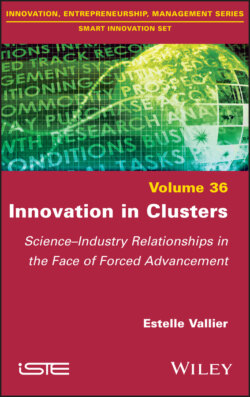Читать книгу Innovation in Clusters - Estelle Vallier - Страница 16
I.3. Acknowledgements
ОглавлениеI would like to thank my colleagues at the Centre Pierre Naville: Émilie Balteau, Philippe Brunet, Fabrice Colomb and Nial Tekin, for their advice and proofreading, so that the original thesis could be transformed into a book. I would also like to thank the teams at Genopole for opening their doors to me and facilitating the investigation. Finally, thanks to Blandine Laperche and Dimitri Uzunidis of the Innovation Research Network for their reconnaissance and support in the publication of this book.
1 1 Formula found on the back cover of Gaglio (2011).
2 2 The Minister of Higher Education at the time.
3 3 Since 2008, the CIR has been calculated as follows: it is equal to 30% of research expenditure less than or equal to 100 million euros and equal to 5% of expenditure above 100 million euros.
4 4 Report to the Assemblée’s nationale’s Finance Commission, “L’évolution et les conditions de maîtrise du crédit d’impôt en faveur de la recherche”, Cour des Comptes, July 2013.
5 5 Some companies, such as Intel and Sanofi, have been singled out in the press for laying off employees while benefiting from CIR.
6 6 The risks of fraud linked to the size of the system were pointed out in the report of the Court of Auditors and, in 2014, a Senate Commission of Inquiry voted not to publish a report on the reality of the deviation from CIR.
7 7 Arnaldo Bagnasco, Carlo Trigilia, Sebastiano Brusco and Giacommo Beccatini.
8 8 Expression referring to the regions of Florence, Bologna, Venice and Treviso, between the prosperous and industrial Italy of the North and the poorer Italy of the South.
9 9 On this point, see the article by Étienne Vergès on the links between the socialist governmental majority and research valorization policies, from the Act of July 15, 1982, to the Fioraso Act of 2013: Vergès E. (2014). Normes de la recherche scientifique, Cahiers Droit, Sciences et Technologies [Online]. Available at: http://cdst.revues.org/346 [Accessed September 30, 2016].
10 10 The 2005 Finance Act defines competitiveness clusters as “groups of companies, higher education institutions and public or private research organizations within the same territory, committed to work in synergy in order to implement economic development projects for innovation” (Finance Act No. 2004-1484 of December 30, 2004).
11 11 This metaphor of a recipe to be reproduced by combining the right ingredients is present in the political discourse around clusters, as well as in that of the business leaders and laboratory directors who operate in these spaces.
12 12 To these three basic ingredients could be added, depending on the space, companies providing support functions (legal, IT, etc.), associations, hospitals (in the case of health clusters), administrations or public bodies, etc.
13 13 https://www.siv.archives-nationales.culture.gouv.fr/siv/rechercheconsultation/consultation/ir/pdfIR.action?irId=FRAN_IR_019764.
14 14 In their triple helix concept (three helices representing academia, industry and government), Leydesdorff and Etzkowitz consider that the central space where the helices overlap forms hybrid organisms that are intended to make the articulation of the three spheres more effective. This concept will be further detailed in Chapter 1.
15 15 http://www.cnrtl.fr/etymologie/interm%C3%A9diaire.
16 16 The sampling method and data collection are detailed in Chapter 6.
17 17 Age, gender, profession, CSP, seniority, reasons for working on the site, the different sociability places or events and the type of relationships they have within the cluster.
